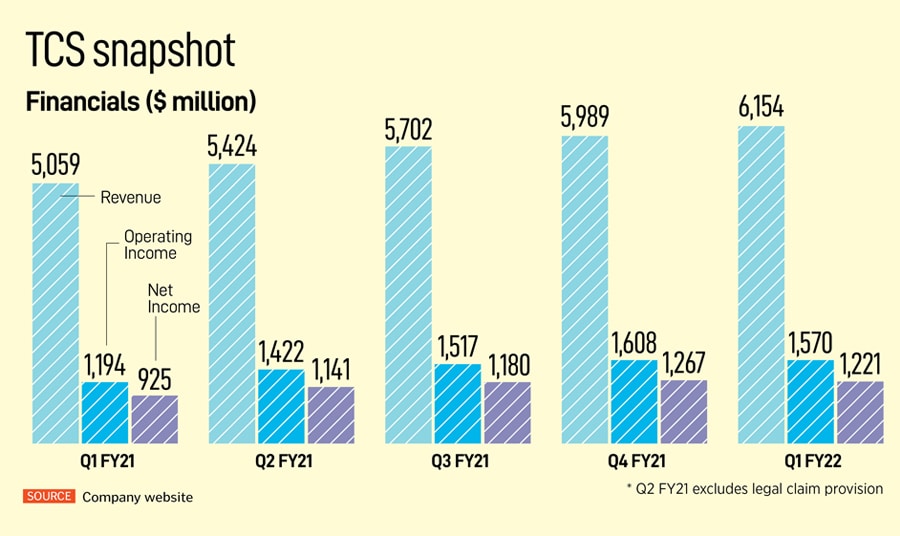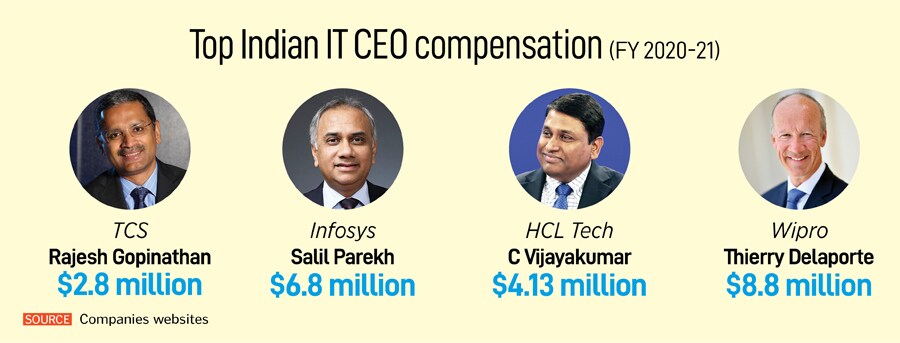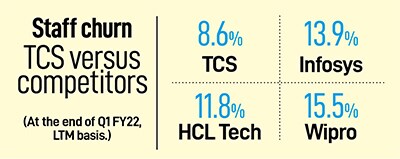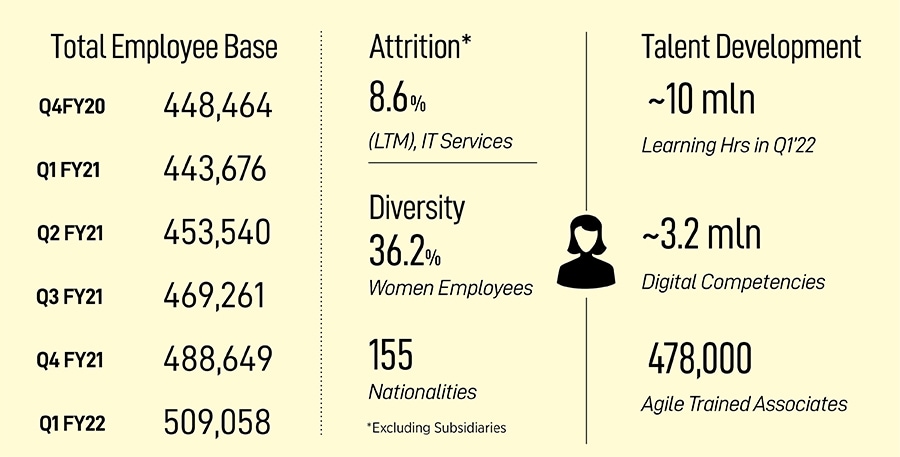While that was a little bit in the future, software-led automation of IT was already here, and customers were looking for solutions. The idea of an AI-driven future that would start with increased automation led CEO Rajesh Gopinathan to decide that TCS, India’s biggest software services provider, and one of the world’s largest, had to systematically take a “machine-first approach", Subramaniam recalls. That meant, “giving technology the first right of refusal in every solution we were crafting". It was the birth of the company’s ‘machine-first delivery model’ that is now well-known in the industry.
Their customers were looking at new ways of working too, to break down silos between teams. They were trying out both physical changes, like incorporating more open office spaces and changes in software development with methods such as ‘agile’ and ‘devops’—to write and deliver code faster, and to facilitate more collaboration between those who wrote the software and those who installed and maintained them. More often, those roles were blurring or overlapping, with cloud computing becoming much more mainstream.
Even before the pandemic, there was change on the horizon, at both the workplace and in the workforce. Cloud computing had made it easy to create an environment in which software and business teams could collaborate better than before to quickly develop solutions, deploy them, test them and iteratively improve them, add features and functionalities and so on.
And then, again, catalysed by the rise of cloud computing, digital technologies were being developed in every industry and coming into play in every business. Pieces of software like application program interfaces (APIs) were gaining popularity because they made it easier to get disparate software products to work together—a fintech company could tap a large bank’s database and the two companies could work together to find new customers and offer new, more personalised products, or a retailer could collaborate with a bank to offer pay-later options to a shopper on the fly through a mobile app.
![]() And sophisticated, self-contained packages of software called containers were being embraced by more IT teams to push more applications onto the cloud than ever.
And sophisticated, self-contained packages of software called containers were being embraced by more IT teams to push more applications onto the cloud than ever.
All this set the backdrop for Gopinathan and his top colleagues to decide that it was time for TCS to embrace the agile philosophy across rank and file, and thus was born the company’s plan for ‘Agile 2020’, which it implemented successfully by last year, even as Covid forced everyone to work from home or remote locations.
This combination of automation, a machine-first approach and the irreversible shift towards cloud computing became the foundation of the new TCS, as it touched the half-a-million employee milestone. Some 40,000 of those came on board last year, and most have never seen a TCS office.
It also set the stage for TCS’s ‘Secure Borderless Work Spaces (SBWS)’ framework, which was quickly conceptualised and rapidly deployed as the pandemic overtook the world. Nothing could have prepared anyone for Covid-19, but certainly the IT infrastructure that TCS had built for itself up until then, to foster more open, aware and collaborative ways of software development and delivery, became the underpinning of SBWS.
Closer to business
All of these, the machine-first delivery model, the Agile 2020 plan and SBWS implementation were pioneering efforts in the industry, and TCS’s customers have seen them in that light, Gopinathan says. Many have used lessons from these for their own benefit too.
“What the pandemic did is, it put a value to resilience because earlier resilience itself didn’t carry a value in a business case. It was considered as a nice-to-have, but if your competitor is four weeks ahead of you, then automatically the value of resilience started becoming a much more quantified one," he explains. And TCS showed customers, and the industry, what it could do to help them become resilient and then build on that.
![]()
Through all this, TCS has been steadily showing clients one other facet that Gopinathan sees as critical for the company’s future—that it has been ready for some time to participate in its biggest clients’ most complex problems at a much more big-picture, abstract level even, than ever—and therefore competing even more directly with its two biggest IT services rivals, Accenture and IBM.
“One of our challenges is that our teams are not the most articulate when it comes to communication and discussions, not the best in communication, even worse so when it comes to written communications and presentations," Gopinathan tells Forbes India.
But after they have interacted with clients for some time, who then get a chance to look beyond the rough edges, TCS’s teams develop very strong connects with the clients. Then, there is respect because the work content and the underlying intellect come through.
Under the Agile 2020 plan, one of the ways in which TCS dealt with communications was by investing heavily in keeping video conferencing channels open between its project teams and their clients round the clock. It got the two sides talking a lot more, but also brought the IT company’s teams closer to the business end of their clients. Mutual respect has systematically increased, Gopinathan says.
Perception gap
That said, closing the perception gap with Accenture or IBM’s IT services business is still “work in progress", the CEO says. “That’s the whole thrust that we are trying to do in communicating TCS’s capabilities to its clients. There’s a lot more of business centricity and business value in the work that the company delivers, which doesn’t necessarily get articulated that way."
![]()
It starts right from the way in which TCS is contracted, and the way in which the work is delivered. It starts with the engineering mindset with which TCS has previously approached its work.
“An engineering mindset would typically value the elegance of the solution," he says. “When given a tough problem, our guys will sit and solve it and then they will go to the client and say, see how easy it is to solve, it can be done so simply, and that collapses the value of the solution."
He continues: “And then you are selling effort to do it, because you are costing it based on the effort. The shift that you need to do is that the value should be associated to the complexity of the problem, not the elegance of the solution."
“I can remember discussing the differences between Accenture and TCS with a CIO from a large insurance company," Peter Bendor-Samuel, founder of Everest Group, which advises businesses on their IT strategy, tells Forbes India via email. “The CIO’s comment was revealing. He said ‘I think both are great firms, however, I use Accenture for white board projects and TCS for key board projects. Every time I try each of them at the other… I am sorry’." The CIO was saying that TCS was great at projects in which execution was key, but frustrating when it came to big-picture transformation. This observation aligns well with many other customers’ experience, Bendor-Samuel says.
![]()
That said, he adds, “TCS has made significant progress in positioning itself for large transformation work, however, it does this in a manner more similar to IBM than Accenture." Like IBM, TCS has accumulated large positions in software and is willing to work with the client on financing the work. Accenture focuses more on the quality of its talent and thought leadership positions with regard to digital transformation.
TCS has worked hard to establish relationships across its clients’ senior management, from the board of directors on down, similar to Accenture and IBM, and like IBM, it seeks to use its investments in IP, platforms and software to win large digital transformation projects. In the overall reckoning, Accenture still has the edge when it comes to large, complex transformational deals, he says.
Gopinathan (50)—one of the youngest CEOs in the Tata Group—recognises that there is also a cultural and historical context here, but “we are closing the gap", he says.
Awareness, Articulation, Amplification
And the work starts from within. TCS is implementing a ‘Triple A programme’ which stands for Awareness, Articulation and Amplification. Start with greater awareness of the value of what the company has achieved, the value of the solutions that it delivers from the point of view of the complexity of the problem, and the value of the outcome, and not from the perspective of the elegance of the solution.
![]()
“This was a big shift because it has to first start inside and we start appreciating the value of what we did," Gopinathan says.
The next step is to equip the rank and file to not exactly show off, but to better articulate what they are capable of. Here again, TCS is overhauling its entire vocabulary under the leadership of chief marketing officer R Rajashree. That she is a stalwart within the company, having been the CTO of the retail practice at TCS, validates the importance of the programme for everyone, Gopinathan says.
The final part of the programme is to amplify the message. The problem with letting the work speak for itself is that TCS engineers sometimes move mountains for their clients, and leave a bulk of the value on the table. If they have delivered work that is valued at 100, they often talk at 60. A more marketing savvy entity could deliver an 80 and talk at 120, the CEO says. “So this 60 to 120 is the value gap that we are leaving on the table. We don’t necessarily want to go to that 120, but moving that 60 closer to 100 is that amplification journey," he adds.
And many customers are on board with this strategy, encouraging TCS to take due credit for their work, and learn to be their own best salesman, he says. Over the course of the last couple of years, TCS has moved into the amplification phase more. Earlier this year, it also wrote itself a new brand statement, ‘building on belief’.
Gopinathan recalls how, two years ago, at an event where customer testimonials were showcased, the company had 22 CXOs on stage, whereas previously, it would have had one or two customers to make keynote speeches. “Our favourite comment internally used to be that in many companies, the brand is far ahead of where the reality is. Our problem is that the reality is far ahead of where the brand is. So now the brand is doing a better job of catching up with where the reality is," he says.
Experts like Bendor-Samuel have noticed it as well. TCS is investing in building relationships up and down the management structure of its clients, from the board to the execution team. It has intentionally moved out from exclusively focusing on the CIO and has broadened its relationship with other stakeholder groups, he says.
TCS has invested in building and sometimes buying software and platforms which position it well in some industries as a strategic partner. This is most successful in insurance and in the run function of IT. The company is attempting to diversify its workforce and hire talent in the US and European Union. By doing this, it seeks to deepen the bench of industry and functional experts. However, it still has far to go to get close to Accenture on this dimension, he says.
TCS has been investing more in marketing and intentionally shaping its brand. This brand-building has succeeded in narrowing the gap with Accenture, he says.
![]()
“Right now, there are a few areas where I’d say the gap exists, other than market perceptions," says Ray Wang, founder and principal analyst at Constellation Research in California, which advises clients on IT strategies. “TCS does not spend enough money on marketing and branding to compete with Accenture. Accenture has also done a better job of promoting individual leaders and their brands in the market. TCS can learn from that as it has so many smart and charismatic leaders."
And this projection starts with Gopinathan himself. When asked about what he needs to do as CEO on projecting his image, he immediately demurred back to talking about how it wasn’t just about him—perhaps this also reflects the characteristics valued in families across India. Humility and achievement are valued over talking about them. Within the Tata Group too, leaders project utter confidence, but in a very quiet way—Gopinathan’s predecessors, N Chandrasekaran, who leads Tata Group, and S Ramadorai are exemplars of that. Execution and humility are valued highly. Branding overseas is only now beginning to get its due.
A historical example of how Accenture has always been good at projecting the value of its expertise is its campaign with golf legend Tiger Woods. That globally integrated marketing campaign led with the tag line ‘Go on. Be a Tiger’ back in 2003—about two years after Accenture went public.
TCS at the time was still a privately held company. It went public in 2004. By the time the global financial crisis came along, TCS was a well-respected IT services provider to many of the world’s biggest banks and financial services providers.
Leading integration management
Following the crisis, mergers and acquisitions were a big driver of value in the industry, and TCS was participating in almost all the important deals. “But we were not seen as participating in, let us say, the integration office that the client sets up in terms of designing what should be the merger strategy, even for systems and processes," Gopinathan recalls.
“I am not talking about the merger strategy from a business strategy perspective. But if a certain synergy benefit was expected, how should the systems and processes be set up to be able to capture it… we were not participating in that. We were participating post that, in actually executing that on the ground," he adds.
Today, TCS is much more aggressively participating in that dialogue—as to what should be the right approach to integration and what should be the prioritisation and what can be done, he says. There are now instances where TCS is the leader on what is called the integration management office.
From not even being part of the integration management office, TCS is now systematically more present in all the integration management offices, when large clients are looking to hand out such contracts. “Now there are instances where we are running the integration management office" with other providers joining in, whether it be organisational change management or audit, finance, or tax.
Consider this more specific example. A large pharmaceuticals company decided to spin out its consumer business and merge it with the consumer business of another pharma company. One question was, when should this carve-out be done. TCS was able to advise the client and convince them that while the separation of the company as a joint venture will happen—and this happened three years ago—TCS would run the joint venture as a separate entity within the existing systems of one of the two parent companies.
![]()
And it is only now that it is actually being separated out into a different system. So while the legal separation happened upfront, “we were able to run it because we laid out to them as to why this would be a better approach than separating it out at the beginning". This is an example of clients recognising TCS’s value much more upstream in complex business transactions, and not just for technology execution, he says.
“Having that kind of a presence, having that kind of a dialogue is new for us," but this is where TCS is going. Gopinathan expects to get in on deals earlier in the process, rather than just at the already-blueprinted IT execution level.
In another instance where there was uncertainty about regulatory compliance related to which part of a business will have to be divested, TCS helped design a solution by which the decision as to what specifically has to be divested was pushed out closer to the deal. “But we set up the environment so that it can be logically separated without what is called a TSA—transition service agreement," he says.
While it has a solid history of always being a strategic provider of IT execution, today, TCS has a lot more participation across the spectrum of activity.
Growth and transformation
What TCS might be five or 10 years down the line isn’t easy to picture, but its work will be even more heterogeneous than it is today. The company is focusing on two aspects today—growth and transformation. And this rests on how TCS positions itself, how it contracts for the work, how it delivers the work, and how it gets rewarded and recognised for the work.
In each of these aspects, Gopinathan and leaders like Rajashree are pushing TCS to jettison the old methodologies of the outsourcing days and embrace business value to the client and the value of outcomes for its customers. And contract and charge accordingly for its work, and be recognised as a provider of the sophistication it brings to the table.
“Our clients are choosing TCS because they are offering a strong balance between technical expertise, business value, and business transformation capability," says Wang at Constellation Research.
![]()
TCS has done a great job building up offerings where customers want them in analytics, automation and AI. The cloud has played a big role in ‘lift and shift’, but new cloud deals are more about transformation. Partnerships have been a strong area as TCS has ramped up its partnerships and the level of depth in those relationships, he says.
“TCS also has brought many corporate research innovations to market quickly and their corporate research team is something to be envious of," Wang says. “When they do lose in deals, it’s not for lack of trying. It is often hard to take out an incumbent like Accenture and IBM in an account. But for net new deals, TCS is highly competitive."
“So if we are successful, we will be successful across all four parts of it," Gopinathan says. Today, from a work content perspective, about 20 percent of the work that TCS does is of this nature—recognising outcomes and value and not the simplicity or elegance of the solution.
But with all four parameters taken together—positioning, contracting, delivery and reward, and recognition—that proportion goes down to less than 5 percent, he says. “Let’s say, you go forward to 2030. I would expect us to be evenly balanced between cost and optimisation, and growth and transformation."
There is the historically strong work that TCS does, which is primarily on the efficiency and optimisation side, and there is newer work, which is on the growth and transformation side. And TCS’s entire approach to these two types of work across the four parameters will be different, and they will be seen to be different from both its clients and the ecosystem that it works in. “So, that would be a great success if we are able to rebalance the company along these two engines, and truly as distinct engines, but working together for the common purpose. That is the aspiration," says Gopinathan."

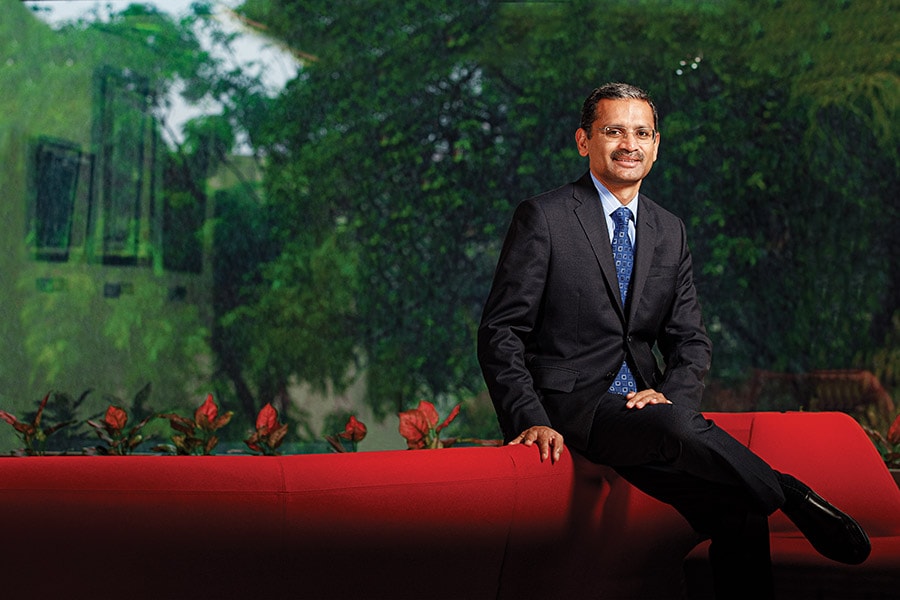 Value should be associated with the complexity of the problem, not the elegance of the solution: TCS CEO Rajesh Gopinathan
Value should be associated with the complexity of the problem, not the elegance of the solution: TCS CEO Rajesh Gopinathan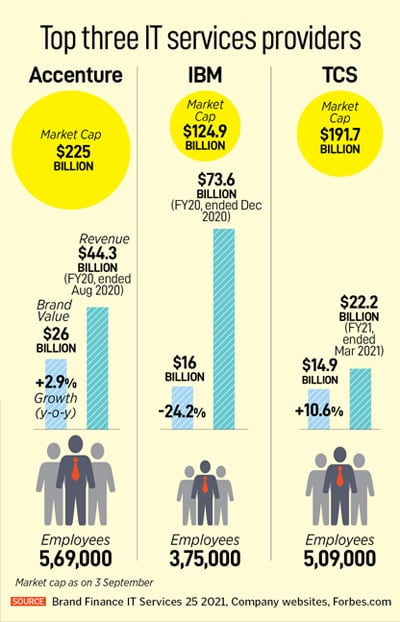 And sophisticated, self-contained packages of software called containers were being embraced by more IT teams to push more applications onto the cloud than ever.
And sophisticated, self-contained packages of software called containers were being embraced by more IT teams to push more applications onto the cloud than ever.
